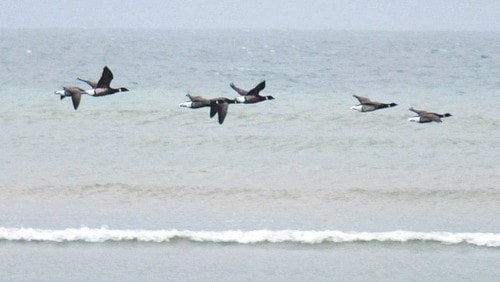Many Sandspit residents are feeling in the dark about plans to protect Shingle Bay and Spit Point for migratory birds.
B.C.’s lands ministry wants to set aside most of the foreshore around Sandspit as a “map reserve” for Pacific Brant and the many other sea and shore birds that gather there in spring.
A “map reserve” only means that no one can get a land tenure there for a commercial or industrial use.
But it’s a step toward creating a wildlife management area, and that is ruffling feathers because it could mean rules on dog walking, fishing, seaweed gathering, or other popular activities along the Sandspit shore.
“It’s a hot issue,” said Bill Beldessi, who represents Moresby Island residents at the North Coast Regional District.
More than 50 people turned out to a March 7 meeting on the issue at the Sandspit Community Hall, and Beldessi said they left with more questions than answers.
“This management plan could be business-as-usual, or it could be absolutely no human contact on that beach,” he said.
“We don’t know.”
Staff at the Haida Gwaii Natural Resource office said someone from the ministry will speak further about the plans for Shingle Bay and Spit Point, but no one was available last week.

Doug Gould, a member of the Moresby Island Advisory Planning Commission (APC), said the whole thing may be a tempest in a teapot — lack of information makes it hard to know.
“We’re afraid of where they’re going with it all,” said Gould, adding that so far, all the APC and regional district have to go on is a map and single-page application sheet.
The Ministry of Forests, Lands, and Natural Resource Operations has recently listed several areas for map reserves, including land for a power line to the Coast Guard radio tower on Moresby, and intertidal areas set aside for a wildlife management area in Lina Narrows.
“Because those aren’t places where people really go and walk a lot, there isn’t reason to oppose it,” said Gould, but that’s not the case on the beach and foreshore around Sandspit.
Gould said the APC was given little time to comment on the proposed map reserve, and questioned the tight timeline for its approval given that Shingle Bay and Spit Point already have a Notation of Interest, meaning the ministry is alerted to any plans for development there.
“Common sense isn’t short of supply here,” said Gould.
“People appreciate the birds — that’s why they walk on the beach, and they’re not deliberately causing any disturbance.”
“I think the government has to show a real justification for the restrictions they want to impose. If it’s protecting the Brandt for a certain amount of time, educate people.”
Beldessi agrees, and said it points to a larger issue.
About 25 years ago, when a similar wildlife zone was proposed around Sandspit, he said there was more discussion with B.C. Lands.
The same was true in the more recent lead-up to the Haida Gwaii land-use plan, when public meetings were held in every islands community.
But Beldessi said consultation with Sandspit residents and the regional district has fallen off since, and the Solutions Table, where B.C. and Council of the Haida Nation representatives review all major land-use applications on Haida Gwaii, isn’t helping.
Months ago, an application to build an eco-tourism lodge at Peel Inlet came to the regional district for comment. The district said they supported it, so long as public access was maintained.
“There was no answer back to us,” Beldessi said, noting that in the past, at least the district had open communication with B.C. Lands, and could appeal to the minister if they had to.
“The Solutions Table was supposed to be the end-all for people on the island — we were all going to work together to find solutions,” he added.
“Well, we were better off with the old system.”
